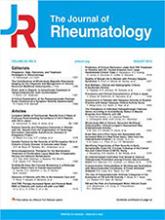
Authors: Natalia de Oliva Spolidoro Paschoal, Jamil Natour, Flavia S. Machado, Hilda Alcântara Veiga de Oliveira and Rita Nely Vilar Furtado
Abstract
Objective. To evaluate the effectiveness and tolerance of intraarticular injection (IAI) of triamcinolone hexacetonide (TH) for the treatment of osteoarthritis (OA) of hand interphalangeal (IP) joints.
Methods. Sixty patients who underwent IAI at the most symptomatic IP joint were randomly assigned to receive TH/lidocaine (LD; n = 30) with TH 20 mg/ml and LD 2%, or just LD (n = 30). The injected joint was immobilized with a splint for 48 h in both groups. Patients were assessed at baseline and at 1, 4, 8, and 12 weeks by a blinded observer. The following variables were assessed: pain at rest [visual analog scale (VAS)r], pain at movement (VASm), swelling (physician VASs), goniometry, grip and pinch strength, hand function, treatment improvement, daily requirement of paracetamol, and local adverse effects. The proposed treatment (IAI with TH/LD) was successful if statistical improvement (p < 0.05) was achieved in at least 2 of 3 VAS. Repeated-measures ANOVA test was used to analyze intervention response.
Results. Fifty-eight patients (96.67%) were women, and the mean age was 60.7 years (± 8.2). The TH/LD group showed greater improvement than the LD group for VASm (p = 0.014) and physician VASs (p = 0.022) from the first week until the end of the study. In other variables, there was no statistical difference between groups. No significant adverse effects were observed.
Conclusion. The IAI with TH/LD has been shown to be more effective than the IAI with LD for pain on movement and joint swelling in patients with OA of the IP joints. Regarding pain at rest, there was no difference between groups. Trial registration number: ClinicalTrials.gov (NCT02102620).
DOI: https://doi.org/10.3899/jrheum.140736


